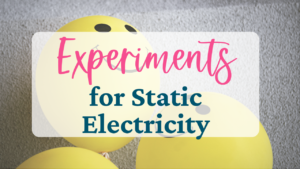
Try out these experiments for static electricity in your classroom. With each experiment static electricity will come to life for your students!
What is static electricity?
All objects are covered in atoms, which are too small to see. Atoms can either have a positive or negative charge. Static electricity is an imbalance between positive and negative charges on the surface of an object. This can be caused by the electric charge created when two objects rub against each other.
What does static electricity do?
Static electricity can cause two objects to be attracted to each other or to repel one another. Two objects are attracted when they have opposite electric charges – meaning one object has a positive charge and one object has a negative charge. Positive and negative charges “like” each other. The objects will repel each other if they have the same charges – meaning both objects have a negative charge or both objects have a positive charge.
Experiment – Static Electricity
Now for the fun! Get your class up out of their seats and experiencing science through hands-on learning. Here are some experiments for static electricity that will SHOW your class this phenomena in action.

Creating Static Electricity with Balloons
Challenge #1: Create your own static electricity using only one object – a balloon.
Start by giving each group a new, deflated balloon. Obviously, the balloon will need to be blown-up for this to work, but they don’t need to know that right away! Enjoy watching as they investigate ways to make the experiment a success. Eventually, they WILL figure out that they need air and a good head of hair to make this one work!
Discussion Points:
-Why weren’t you able to build much static electricity with the deflated balloon? (There is less surface area; therefore, less surface area to collect atoms needed to create static electricity.)
-What happens when you hold the balloon close to your hair? Why do they attract each other? (The balloon surface is negatively charged and your hair has a positive charge.)
-Can you find anything else with a positive charge? …negative charge? Search the room!
Static Electricity with a Can
Challenge #2: Make an empty pop can roll across the table without touching it!
What?! Most people have no ideas you can do this and your class will think it’s SO cool. They’ll be excited to go home and use their new magic trick on their families!
They’ll just need a balloon that is charged with static electricity and an empty pop can. There are actually two challenges for this one:
1.Make the can roll AWAY from you without touching it.
2.Make the can roll TO you without touching it.
Discussion Points:
-If the balloon has a negative charge, what charge does the empty can have? (positive)
-Are you able to make any changes to cause the can to move more quickly? (Ideas: Add more static electricity. Add a incline to add gravity as a force. Continue for a longer distance to build momentum.)
-Once your can is rolling, how can you quickly stop it without touching it? (Place the balloon on the opposite side.)
Jumping Pepper
Challenge #3: Use static electricity to separate some pepper from a pile of equally mixed salt and pepper.
This one is bound to get your class all worked up! Start by dumping salt into a clear or white dish (like a paper plate). Next, dump an equal amount of pepper into the dish. Explain the challenge as your dramatically stir the two together. Place small piles on separate white dishes and hand them out to small groups. Allow some time for them to sort by hand. Once they’re feeling like the task is impossible, hand out the balloons.
Discussion Points:
-What did you notice was attracted to the balloon more? (pepper)
-If the balloon has a negative charge, what charge do the salt and pepper have? (positive)
-If salt and pepper both have a positive charge, why was there more pepper on the balloon? (Pepper is lighter and easier to pick up.)

Create a classroom full of laughter, learning and a love for science with these experiments for static electricity!
Want more lessons & activities? Join the Grace Over Grade email community!
Don’t forget to Pin this lesson on Static Electricity!





